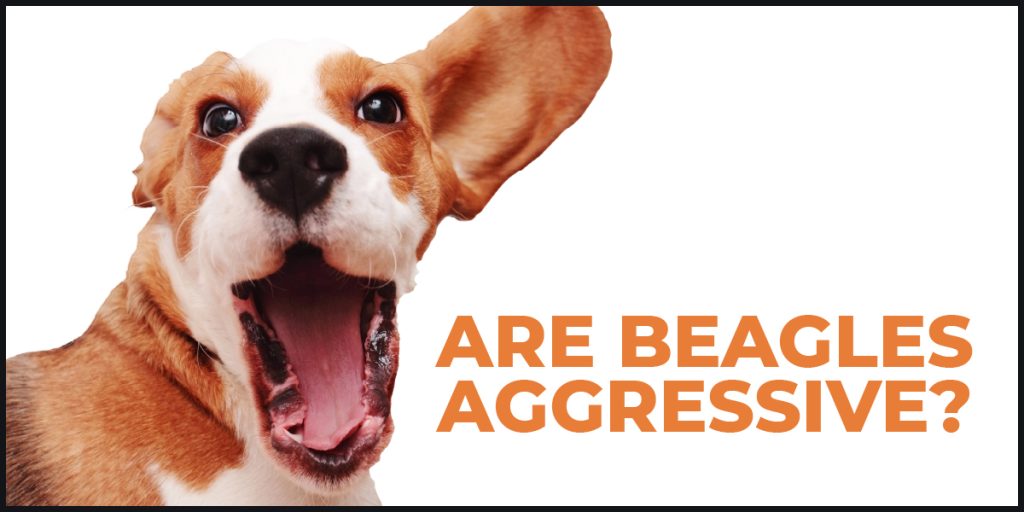How do you transform a challenging moment into a teaching opportunity with your beagle? This article uncovers the rare but real instances when a usually gentle beagle might react aggressively, outlining the triggers and offering effective strategies to address them.
We’ll also guide you through effective techniques to keep your beagle as peaceful and playful as ever, turning concerns into moments of growth and bonding.
 Key Takeaways
Key Takeaways
- Beagles are inherently sociable and affectionate, not prone to aggression. However, specific triggers like fear, territorial instincts, or challenges to their dominance can provoke aggressive responses.
- It's crucial to recognize early signs of stress or aggression in beagles, such as growling, stiffening posture, and hard stares. Identifying these signs helps prevent escalation and improves your understanding of your beagle’s comfort levels.
- Preventing and managing aggression in beagles requires a combination of early socialization, consistent training using positive reinforcement, strong leadership, and seeking professional help when needed.
Find out how to train your beagle to be the well-behaved pup you desire – Read Free Report
Unraveling the Myth: Are Beagles Naturally Aggressive?

Image created by AI
Often referred to as ‘goldilocks dogs‘ for their balanced traits, beagles are far from being inherently aggressive. Surrounded by misconceptions, some believe these dogs have a natural tendency toward aggression, but that's a stark misrepresentation. In reality, beagles are friendly, sociable, and deeply loyal, making them beloved family members.
Don't just take our word for it; consider their popularity. The American Kennel Club lists beagles as the 8th most popular breed among 199, underscoring their widespread appeal as family pets. Additionally, the National Beagle Club of America praises them for their affectionate yet independent nature. It's important to recognize that any aggressive behavior in beagles is usually triggered by specific situations rather than an innate characteristic, a topic we'll delve into next.
The Root of Aggression in Beagles

Image created by AI
Aggression in beagles is more circumstantial than innate. Not all beagles display aggression, but like any other dog breed, it is a behavior that can be present in some. Common triggers include:
- Fear
- Territorial behavior
- Dominance
- Health-related issues
Also, aggression can be a response to discomfort or perceived threats.
Bear in mind, before we delve into the root causes of aggression, that beagles are bred for companionship, not combat. So, any aggressive behavior is atypical and context-specific. Now, let’s dissect these triggers for a better understanding of our beagle buddies:
- Fear or anxiety
- Resource guarding
- Lack of socialization
- Frustration or boredom
- Pain or illness
- Territoriality
By identifying and addressing these triggers, you can help prevent or manage aggression in your beagle.
Territorial Instincts and Resource Guarding
Like many dog breeds, beagles possess a natural territorial instinct. They often guard their space and possessions, which can manifest as aggressive behaviors such as growling or snapping if someone approaches their food or enters their perceived territory.
However, these behaviors can be effectively managed with strong leadership and proper training. Teaching your beagle to yield around valued items and carefully managing their encounters with unfamiliar people or other animals can significantly reduce these aggressive tendencies. By consistently applying these strategies, you can help your beagle feel secure and behave more peacefully in their environment.
Fear and Anxiety Responses
Fear aggression in beagles often arises as a way to put distance between themselves and perceived threats, and can be either defensive or offensively proactive, especially following negative experiences.
This behavior may stem from poor socialization, past trauma, or genetic factors. Early and thorough socialization can greatly reduce its occurrence, while established fear aggression can be managed through focus redirection, positive reinforcement, and professional assistance when necessary.
Dominance Assertion Among Dogs
Another potential trigger for aggression in beagles is dominance assertion. This behavior can be observed when an aggressive beagle perceives itself as the alpha dog and believes it is in charge. Such a mindset can stem from their natural pack animal instincts, leading to aggression when they feel their dominance is challenged or when they are asserting their perceived hierarchical position. In this context, it is essential to understand if beagles aggressive dogs are a common occurrence or an exception.
The signs of dominance assertion can range from growling and baring teeth to barking. Understanding these signs and the motivations behind them can help manage this form of aggression. Despite these behaviors, it’s worth noting that beagles are not inherently aggressive dogs. These actions are merely their way of communicating their discomfort or insecurity.
Decoding Beagle Aggression: Signs and Signals

Image created by AI
Understanding and recognizing signs of aggression in beagles is crucial to prevent potential injuries and better understand their behavior. Common indicators include growling, barking, and nipping—where nipping often serves as a warning that the dog feels threatened or uncomfortable.
Look for subtler behavioral cues as well, such as a sudden closing of the mouth that was previously open, ears pulling back, or a ‘stutter walk.' These signs can signal stress in beagles, which, if not managed, may escalate into aggression. Recognizing these signs early can help you address your beagle's needs more effectively. Let’s explore these signals in more detail.
Understanding Beagle Body Language
Learning to read a beagle's body language is key to differentiating between playful and aggressive behaviors. Keep an eye out for certain postures that might suggest aggression:
- A forward-leaning stance
- Stiff body posture
- Tail positioned above the horizon
- Raised hackles along the back
These behaviors may indicate aggressive biting.
Facial expressions can also provide a wealth of information about a beagle’s emotional state. Here are some examples:
- An aggressive grin
- Wrinkles around the eyes and lips
- A direct threatening stare
- Wide-open and rounded eyes
Conversely, oval-shaped eyes that do not show the white part (sclera) usually signal that a beagle is calm and friendly, lacking aggressive intentions. Recognizing these signs will allow you to better understand and respond to your beagle’s needs.
Vocalizations and Their Meanings
Vocalizations in beagles, including barking and growling, serve as indicators of a range of emotions. Barking isn't necessarily a sign of aggression; it often expresses excitement, alertness, or other feelings. Growling, while sometimes playful, can also serve as a warning that the beagle perceives a potential threat.
Be alert to combinations of behaviors such as a hard stare accompanied by:
- Growling
- Barking
- Snarling
- Snapping
These patterns can be early warning signs of aggression. By recognizing and understanding these vocal cues, you can better predict and manage your beagle’s reactions, ensuring appropriate responses to their emotional state.
Physical Gestures of Discontent
Physical gestures of discontent in beagles can range from subtle warnings to more pronounced aggressive actions. Initially, a beagle might show its unease through the following behaviors:
- A hard stare
- A snarl
- A snap
- A bite with inhibited force
These gestures represent the beagle's efforts to communicate distress and attempt to prevent conflict without resorting to full aggression.
More definitive signs of aggression include:
- Stiff body posture
- Raised hackles
- A high and stiffly wagging tail
- Direct eye contact
By recognizing the progression of these signs—from hard stares to growling and snapping—you can intervene before these behaviors escalate to lunging or biting, both of which are serious indicators of aggression, especially in interactions with other dogs. Understanding these signals is crucial in preventing conflicts and ensuring safe interactions.
Preventing and Managing Aggressive Behavior in Beagles

Image created by AI
Understanding the root causes and signs of aggression is crucial, but equally important is knowing how to effectively manage and prevent such behavior. Implementing training techniques such as obedience training, positive reinforcement, and behavior modification is key to curbing aggression in beagles. Consistency in training, coupled with positive rewards like treats, praise, or toys, helps reinforce desirable behavior.
Effective leadership, characterized by calm assertiveness, plays a pivotal role in influencing a beagle's behavior, setting the stage for a peaceful environment that minimizes the likelihood of aggression. Additionally, socialization is vital; exposing beagles to positive interactions with other animals and people can boost their confidence and alleviate anxiety.
Let's explore these strategies further to understand how they can be applied to ensure your beagle remains well-behaved and sociable.
Establishing Leadership Without Intimidation
Beagles thrive under clear, patient, and empathetic leadership. They seek guidance, rules, and protection from their human ‘pack.’ Effective leadership conveys self-confidence and consistency, setting an example for the beagle to follow, thereby creating a harmonious relationship.
As a beagle owner, you can assert leadership by teaching your beagle polite leash-walking, patiently guiding them through doors and stairs, and leading their play activities. Leadership is fostered by calmly teaching the beagle to obey commands, understand defined personal and territorial spaces, and accept handling. These tips are essential for beagle owners who want to establish a strong bond with their pets.
Socialization and Its Role in Curbing Aggression
Socialization is key to reducing aggression in beagles. Initiating socialization early, ideally before they are 16 weeks old, is essential for preventing aggressive behaviors and helping beagles feel at ease around other dog breeds and people.
Proper socialization contributes to better mental health for beagles, building trust and fostering a deeper understanding with humans. Consistently introducing beagles to new experiences, paired with positive reinforcement, can diminish the likelihood of behavioral problems and aggressive tendencies.
Positive Training Techniques
Positive training techniques focus on rewarding beagles for desired behaviors, using treats, praise, or play to encourage repetition of these actions. This approach not only reduces the likelihood of aggression but also fosters a positive relationship between you and your beagle.
Understanding a beagle’s lively and independent nature is crucial for effective training, particularly with puppies. Providing ample play, exercise, and a secure environment, such as a crate, helps manage their energy and behavior.
By establishing structured training routines in a supportive environment and avoiding negative reinforcement like hitting or yelling, you build a foundation of trust and respect with your beagle. This method promotes long-term positive behavior and emotional health.
When to Seek Professional Help for Your Beagle's Aggression
Managing minor aggression in beagles with the techniques we've discussed is often effective, but sometimes professional help is necessary. Consider seeking a professional if:
- The aggression has resulted in injuries or poses a serious risk.
- Traditional training methods have been ineffective.
- Techniques like desensitization or counterconditioning are needed.
If your beagle's aggression is particularly challenging to manage or causes harm to others, this signals a critical need for professional intervention. Situations where aggression escalates due to inconsistent responses from humans or repeated reinforcement of aggressive behaviors also warrant consulting an expert.
Next, we'll delve into how and when to seek this expert assistance effectively.
Identifying Behavioral Issues That Need Expert Attention
Recognizing when behavioral issues in beagles require expert intervention is essential for the safety and well-being of both the dog and its family. If traditional training methods are ineffective at addressing recurring aggression, seeking a professional’s expertise may be necessary.
Frustration in beagles, which often leads to aggression, can result from inconsistent responses from their owners. If you find yourself struggling to manage your beagle’s frustration or subsequent aggression, professional assistance can provide the guidance and strategies needed to resolve these issues effectively.
Options for Professional Training and Therapy
Behavior modification programs offered by professional trainers are key in addressing aggressive behavior in beagles. These programs, focusing on desensitization and counterconditioning, employ positive reinforcement techniques and may use tools such as leashes, head halters, and basket muzzles in structured plans.
Tailored treatment plans, designed by veterinary behaviorists or professional trainers, are crucial for effectively managing aggression. These plans typically involve:
- Managing the beagle’s environment to remove or reduce stress triggers.
- Teaching them new, appropriate responses to stimuli that previously elicited aggression.
- Addressing any underlying health issues that might be contributing to the aggression, ensuring a holistic approach to behavior modification.
These comprehensive strategies are designed to transform challenging behaviors into positive outcomes, fostering a safer and more understanding relationship between beagles and their owners.
Creating a Harmonious Home: Beagles and Family Life

Image created by AI
Beagles are generally mild-mannered and known for their friendly and well-behaved temperament. These traits, combined with proper socialization and proper training, make them great family dogs. Whether it’s in rural areas or large metropolitan cities, beagles can adapt to a range of living conditions, making them a beloved breed for many dog owners.
Beagles are loyal, affectionate, and playful, making them fitting pets for family environments. Their adaptable nature and affectionate behavior make them particularly compatible with children and other pets. So, how do we ensure a harmonious home environment with our beagle companions? Let’s explore this further.
Beagles as Family Members
Beagles are known for their mild-mannered, friendly temperament, qualities that, alongside proper socialization and training, make them excellent family pets. They adapt well to various living conditions, thriving both in rural settings and in bustling metropolitan areas, which contributes to their popularity among diverse households.
Loyal, affectionate, and playful, beagles blend seamlessly into family environments. Their ability to get along with children and other pets makes them particularly endearing. But what steps can we take to ensure a harmonious home with our beagle companions? Stay tuned as we delve into strategies that foster a peaceful coexistence.
Encouraging Gentle Interactions
Encouraging gentle interactions between beagles, family members, and other pets is key to maintaining a harmonious living environment. By consistently using positive reinforcement and steering clear of situations that could trigger anxiety or aggression, you can cultivate a beagle's gentle demeanor.
Regular reinforcement of these gentle behaviors is crucial for a beagle’s social development, helping them become more affable and safe companions for children and other pets. By frequently practicing these strategies, you ensure that your beagle behaves consistently and safely within the family dynamic.
Summary
Beagles may sometimes exhibit aggression, but this behavior is not inherent to the breed. By understanding the root causes of aggression, recognizing the early signs, and applying effective management strategies, you can guide your beagle toward more positive behaviors. Committing to consistent training, coupled with love and patience, ensures that beagles become harmonious additions to any family.
Remember, each beagle is unique, and catering to their individual needs and personalities is crucial for a happy, healthy relationship. As responsible beagle owners, our role is to provide a supportive and engaging environment where they can thrive and be part of every family adventure, safely and joyfully.
Frequently Asked Questions
Is it common for beagles to be aggressive?
No, beagles are not more aggressive dog than any other breed. With proper training and early socialization, they can be playful, not aggressive.
Are beagles good family dogs?
Yes, beagles are great family dogs due to their affectionate and companionable nature, making them an ideal pet for many families. They are also described as “merry” by fanciers, and have been popular breed among American pet owners for years.
Why does my beagle growl at me?
Your beagle may be growling as a way of communicating that they are uncomfortable or need space. It's important to pay attention to their body language and behavior to understand the message behind the growling.
What can cause aggression in beagles?
Aggression in beagles can be caused by fear, territorial behavior, dominance, and health-related issues. It's important to address these triggers to help manage their behavior.
How can I prevent and manage aggression in my beagle?
To prevent and manage aggression in your beagle, focus on obedience training, positive reinforcement, and behavior modification. Additionally, establishing effective leadership and ensuring proper socialization are crucial for addressing aggression in beagles. The OMG Beagle website and blog is another place to find additional resources.
Learn how to train your beagle to be the well adjusted dog you desire –> Access our Free Report
Shop for beagle-themed products and gifts that beagle enthusiasts will love.
